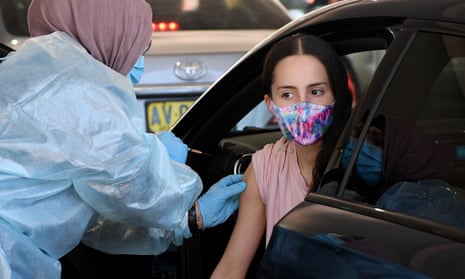Australia’s booster rollout is lagging behind other countries as the vaccination program continues to suffer the ripple effects of the slow initial rollout.
Millions of eligible Australians are yet to get their third Covid-19 vaccine dose, and the daily vaccination numbers are dropping.
Australia is ranked seventh in the OECD for second doses administered, but just 22nd when it comes to boosters. Many countries have been plagued with slow and slowing booster rollouts, but Australia’s booster program began later than most OECD countries. Compounded by restricted eligibility, the booster rate in Australia is slower than many countries that have higher vaccination rates.
Experts say that declining Covid case numbers and perceptions that Omicron is not as severe may be contributing to the low takeup. Recent high case numbers may also be contributing to the sluggish rate, as some delay their next shot until after they have fully recovered from infections.
Dr Jane Frawley from the University of Technology Sydney suggests targeted messaging campaigns may be needed to encourage more Australians to get a booster. Frawley and her colleagues recently launched decision aids to help adults and parents work through their choices about getting vaccinated.
Guardian Australia’s booster tracker shows that the same number of people have received booster shots as had received second doses over five months ago. The gap has only been increasing in recent weeks despite eligibility being reduced to three months for anyone aged over 16 years.
Over 19m second doses had been administered three months ago. With just over 12.2m boosters administered, there are about 7 million Australians eligible for boosters that have not had them.
More than half of all the second doses administered in 2021 were in the last four months. So a huge percentage of the population – especially younger Australians – only started becoming eligible for boosters this year.
The daily booster rate appears to have been responsive to increasing availability. There was a huge increase in boosters administered when eligibility was expanded in early December to anyone 18 or over who had had a second dose at least five months previously.
The rate dipped towards the end of December, especially once five-to-11-year-olds became eligible for their first doses and parents began competing for vaccination slots. The rate increased again as eligibility expanded to four months and the Omicron wave started, but it has since fallen away despite repeated eligibility expansions.
Guardian Australia previously found that the lowest level of booster uptake was in younger Australians, which has been confirmed by recent data from the department of health.
“That age group had a lot of cases within it, the younger 18-24 age group. That’s one reason you’re seeing a lower uptake in boosters” says Frawley.
As case numbers have dropped from highs in early January, politicians have stopped appearing daily on television and searches for Covid boosters have dropped away. Frawley says that this lack of salience may also be contributing to the lower booster takeup.
“If it’s not being reported in your space regularly, every day, you’re not seeing it. It’s not a topic of conversation. You’re not talking about how many have lost their lives. It’s not front and centre. We are not getting those messages out effectively any more.
“When the booster was first offered we were much better at messaging the importance of the booster and why you should get one.
“Perhaps what we need is targeting messaging. If we are worried about the 18, 19, 20-year-olds then maybe we need targeted messaging to tell them why they should bother. To tell them why they should make an appointment.”
Data from around the world confirms that Australia isn’t alone in having a slow booster rollout. In the United States, United Kingdom, New Zealand and South Korea the daily booster numbers peaked in late December or early January.
Frawley says “we are pretty much on par” with booster uptake around the world.
“This is phenomena we have seen everywhere. So primary doses weren’t too bad, especially in older age groups. But boosters have been slow everywhere.”
“The message still needs to be to have a booster”.
“[You are] less likely to get it. Less likely to get it severely. Less likely to pass it on. Less likely to get really sick. Less likely to have long-term consequences like long Covid. And to add to that, we don’t know what’s around the corner. We don’t know if we are going to see something that is a little bit nastier.”
